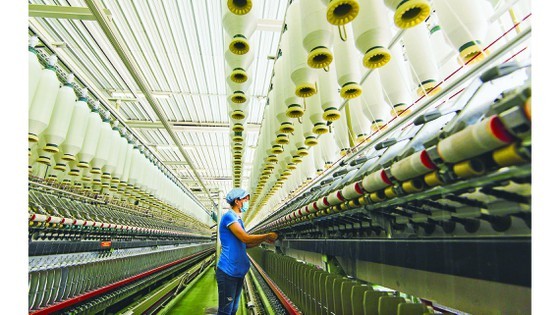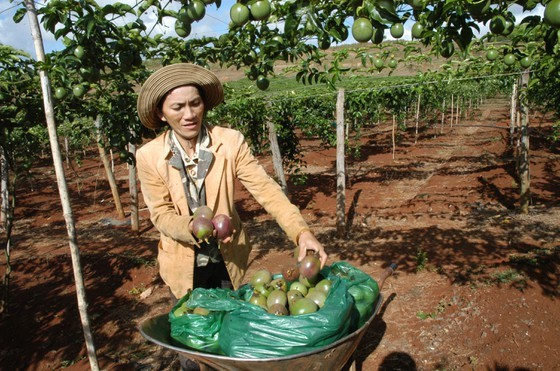
Many enterprises are ready
The rapid change in the source of imported raw materials must first be mentioned in the garment and textile sector. Many enterprises have switched to buying material fabrics from the South Korean and Japanese markets to take advantage of cumulative rules of origin to enjoy preferential export tax rates following the EVFTA's regulations.
Mr. Nguyen Tien Truong, General Director of the Vietnam National Textile and Garment Group (Vinatex), said that the domestic source of textile and garment materials only meets 20 percent of production demand. To enjoy tax rates under the EVFTA, enterprises need to add 25 percent more of raw materials imported from countries that have signed FTAs with Vietnam and the EU. Vinatex has quickly switched to buy fabric materials from Japan and South Korea.
Currently, it is estimated that the amount of imported fabric materials from these two markets has added about 25 percent of the total domestically produced material fabrics with 17 percent from the South Korean market, and 8 percent from the Japanese market. Thus, if the cumulative rule of origin is applied, Vietnam's textile and garment export products fully satisfy the rules of origin to receive preferential tax rates into the EU market.
In the field of agriculture, forestry, and fisheries, many enterprises have upgraded production technology and improved product quality. According to Nafoods Group Joint Stock Company, to penetrate the EU market, the company has modernized its production technology to meet the EU's food safety and hygiene standards, and invested in building a 1,500-hectare growing area of passion fruit plants under natural farming processes in the Central Highlands province of Gia Lai.
Until now, when the EVFTA is passed, this raw material area has been put into exploitation. With preparation along with the preferential tax rate of zero percent, the Nafoods group almost faces no barriers when entering the EU market. It is estimated that the company's exports of food products, mainly passion fruits and some tropical fruit juice concentrates, to the EU will exceed US$15 million per year.
The rapid change in the source of imported raw materials must first be mentioned in the garment and textile sector. Many enterprises have switched to buying material fabrics from the South Korean and Japanese markets to take advantage of cumulative rules of origin to enjoy preferential export tax rates following the EVFTA's regulations.
Mr. Nguyen Tien Truong, General Director of the Vietnam National Textile and Garment Group (Vinatex), said that the domestic source of textile and garment materials only meets 20 percent of production demand. To enjoy tax rates under the EVFTA, enterprises need to add 25 percent more of raw materials imported from countries that have signed FTAs with Vietnam and the EU. Vinatex has quickly switched to buy fabric materials from Japan and South Korea.
Currently, it is estimated that the amount of imported fabric materials from these two markets has added about 25 percent of the total domestically produced material fabrics with 17 percent from the South Korean market, and 8 percent from the Japanese market. Thus, if the cumulative rule of origin is applied, Vietnam's textile and garment export products fully satisfy the rules of origin to receive preferential tax rates into the EU market.
In the field of agriculture, forestry, and fisheries, many enterprises have upgraded production technology and improved product quality. According to Nafoods Group Joint Stock Company, to penetrate the EU market, the company has modernized its production technology to meet the EU's food safety and hygiene standards, and invested in building a 1,500-hectare growing area of passion fruit plants under natural farming processes in the Central Highlands province of Gia Lai.
Until now, when the EVFTA is passed, this raw material area has been put into exploitation. With preparation along with the preferential tax rate of zero percent, the Nafoods group almost faces no barriers when entering the EU market. It is estimated that the company's exports of food products, mainly passion fruits and some tropical fruit juice concentrates, to the EU will exceed US$15 million per year.
 Passion fruits for export are grown in Lam Dong Province. (Photo: SGGP)
Passion fruits for export are grown in Lam Dong Province. (Photo: SGGP)
In the opposite direction, European companies also increase their presence in the Vietnamese market. Mr. Nicolas Audier, EuroCham Chairman, said that many enterprises, specializing in manufacturing equipment and machinery for the garment and textile, leather and footwear industry, clean energy, and food processing, are promoting their trade promotion activities and approaches to Vietnamese enterprises. EuroCham’s latest survey shows that a quarter of European enterprises have benefited from the tax rescheduling of the Government. In which, about one-fifth of enterprises have received additional benefits from the reduction of land rent and the suspension of social insurance contribution. This has helped increase the optimism index of European enterprises about Vietnam's the trade and investment environment.
Taking advantage of made-in-EU technology
According to the Vietnam Textile and Apparel Association, the export scale to the EU market of the textile and garment sector is $250 billion, but Vietnam has only exported $5.5 billion, so the market room is still very large. From the beginning of August, about 18 percent of total textile and garment exports of Vietnam to the EU market enjoy the tax rate of zero percent. The remaining proportion will be reduced over the next three years and seven years. Besides changing suppliers of raw materials, enterprises need to consider importing and upgrading production technology from Europe, especially the technology of producing raw and auxiliary materials for the garment and textile sector.
According to Mr. Le Tien Truong, Europe is the world’s leader in the production technology of raw materials for garment and textile, leather and footwear, and food processing industries. Moreover, the prices of European technology have also been adjusted to the same level as many countries around the world and in Asia. Therefore, if we aim to export to the European market, using European production technology can help immediately eliminate technical barriers to the environment, social responsibility, quality standards, and food hygiene and safety in general.
Assessing the potential of the EU market in the coming time, the MoIT said that the main export markets of Vietnam, such as the US, South Korea, Japan, and especially Europe, have loosened the social distancing policy. Accordingly, people's consumption and shopping demands are increasing, especially in the last months of the year, holidays, Christmas, and New Year.
Minister Tran Tuan Anh of the MoIT said that the ministry has proposed the Government to increase the number of commercial counselors in two key markets, namely Europe and the US, to help enterprises get more in-depth information on consumer demand in these markets, at the same time, set up a website specializing in the EVFTA, propagating regulations on rules of origin to enterprises. As for some agricultural products, to improve the brands and promote the export of agricultural products to developed countries, the ministry has applied the blockchain technology in tracing the origin of goods with Idea-blockchain stamps. Moreover, the ministry has also set up branded emails, participated in domestic and international e-commerce exchanges to support the business community to promote online sales.
Mr. Vu Tien Loc, Chairman of Vietnam Chamber of Commerce and Industry suggested authorities continuing to simplify administrative procedures to create a more favorable business environment for enterprises. Moreover, authorities should legalize the supporting industries, creating conditions for the industry to develop sustainably, because this is the foundation to attract the shift of global supply chains to Vietnam and solve the shortage of domestic raw materials, reducing dependence on imported raw materials. On the other hand, it will contribute to increasing the competitiveness of export enterprises.
























